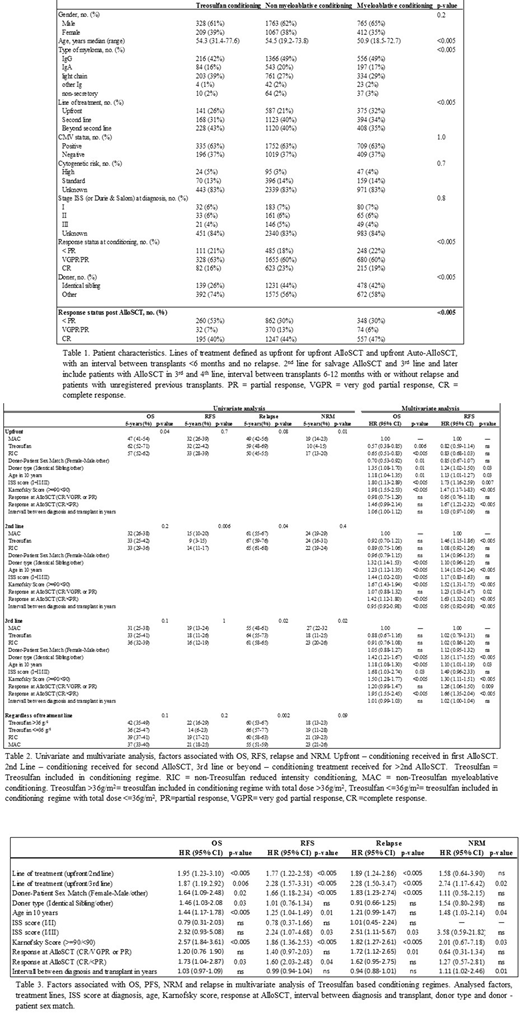Abstract
Background
Allogeneic hematopoietic stem cell transplantation (AlloSCT) for treatment of multiple myeloma (MM) is controversial mainly due to high non-relapse mortality (NRM) with myeloablative conditioning. However, AlloSCT is probably the only treatment that result in cure of a small fraction of patients. Treosulfan is a prodrug of a bifunctional alkylating agent which has both myelotoxic and immunosuppressive properties. Conditioning regimes with treosulfan have been tried in various hematologic neoplasia such as AML and MDS indicating low NRM and increased progression free survival (PFS). Previous studies on use of treosulfan condition in AlloSCT for MM indicated feasibility, stable engraftment and low NRM. In the present study we have analysed the results of low and high dose treosulfan respectively on OS, RFS, relapse incidence and NRM as well as results of Treosulfan conditioning compared to non-Treosulfan reduced intensity conditioning (RIC) and non-Treosulfan myeloablative conditioning (MAC).
Patients and Methods
We conducted a retrospective analysis of 4544 patients with MM undergoing AlloSCT 2008-2016 reported to the EBMT data registry. Out of 537 patients receiving Treosulfan based conditioning the impact of dose could be analysed in 441. Three hundred and twenty-seven patients received a total dose of >36g/m2 and 114 <=36g/m2.These patients were compared to 2830 patients receiving RIC, and 1177 receiving MAC. 1103 patients were transplanted upfront and 3441 patients in later lines following relapse/progression. Patient characteristics shown in table 1.
Results
The 5-year OS in upfront Treosulfan conditioned patients was 62%, which was significantly superior to both non-Treo RIC and MAC patients respectively, apparently due to a tendency for lower NRM (10%) albeit a higher relapse rate (Table 2). Patients in later lines of conditioning had either low NRM (3rd line) or no significant difference (2nd line) (Table 2). Heterogeneity in the material makes it difficult to interpret results in the patients transplanted late in the course of the disease.
A higher total treosulfan dose, >36g/m2, showed a tendency for improved OS and RFS compared to the lower dose treosulfan as well as RIC and MAC (table 2) respectively.
In multivariate analysis of upfront transplanted patients, with a model adjusted for ISS score at diagnosis, age, Karnofsky score, response at AlloSCT, interval between diagnosis and transplant, donor type and donor - patient sex match, treosulfan and RIC retained significance for OS, HR 0.57 (P=0.006) and RFS, HR 0.65 (P=<0.005). For 2nd line Treosulfan RFS was significantly worse, HR 1.46 (P=<0.005) while there was no significant difference for OS between conditioning regimes in 2nd or for OS and RFS in 3rd line (table 2). The factors associated with most inferior OS in upfront line of conditioning was Karnofsky <90 and ISS score III at diagnosis. ISS score III at diagnosis was also associated with inferior OS also in 2nd and 3rd line (Table 2) A less then partial response at AlloSCT was consistently a factor associated with inferior RFS regardless of line of treatment with HR 1.67 (P=<0.005) in upfront, HR 1,63 (P=<0.005) in 2nd line and HR 1,66 (P=<0.005) for 3rd line or later (Table 2)
In multivariate analysis of treosulfan based conditioning regimes, upfront line of conditioning was superior for OS, PFS and relapse as expected (Table 3). Notably was an increased hazard ratio for donor-patient sex match other than female to male in OS, PFS as well as relapse, HR 1.64 (P=0.02), HR 1.66 (P=0.004) and HR 1.83 (P=0.003) respectively (Table 3).
Conclusions
Conditioning upfront with Treosulfan containing regimens for AlloSCT in multiple myeloma, is associated with a superior overall survival and a low NRM, however with a slightly higher relapse rate compared to other regimens. A higher dose > 36g/m2 tends to further improve OS, RFS and relapse rate without increasing NRM. The better results of Treo conditioning in female to male transplants as compared to other sex combinations and in contrast to MAC transplants may be due to the overall lower NRM with treosulfan, thus utilizing the GVM more effectively as indicated by the trend for lower relapse rate. In conclusion, Treosulfan containing regimens appear to be of value in upfront AlloSCT. Prospective studies on Treosulfan conditioning are warranted to further define the best dosing in MM AlloSCT.
Niederwieser:Miltenyi: Speakers Bureau; Novartis: Research Funding. Beelen:Medac: Consultancy, Other: Travel Support. Stelljes:Pfizer: Consultancy, Honoraria, Research Funding; MSD: Consultancy; JAZZ: Honoraria; Amgen: Honoraria; Novartis: Honoraria. Finke:Novartis: Consultancy, Honoraria, Other: travel grants, Research Funding; Medac: Consultancy, Honoraria, Other: travel grants, Research Funding; Neovii: Consultancy, Honoraria, Other: travel grants, Research Funding; Riemser: Consultancy, Honoraria, Research Funding. Garderet:Amgen: Consultancy; Celgene: Consultancy; Takeda: Consultancy. Kroeger:Celgene: Honoraria, Research Funding; Riemser: Honoraria, Research Funding; JAZZ: Honoraria; Novartis: Honoraria, Research Funding; Sanofi: Honoraria; Neovii: Honoraria, Research Funding.
Author notes
Asterisk with author names denotes non-ASH members.


This feature is available to Subscribers Only
Sign In or Create an Account Close Modal